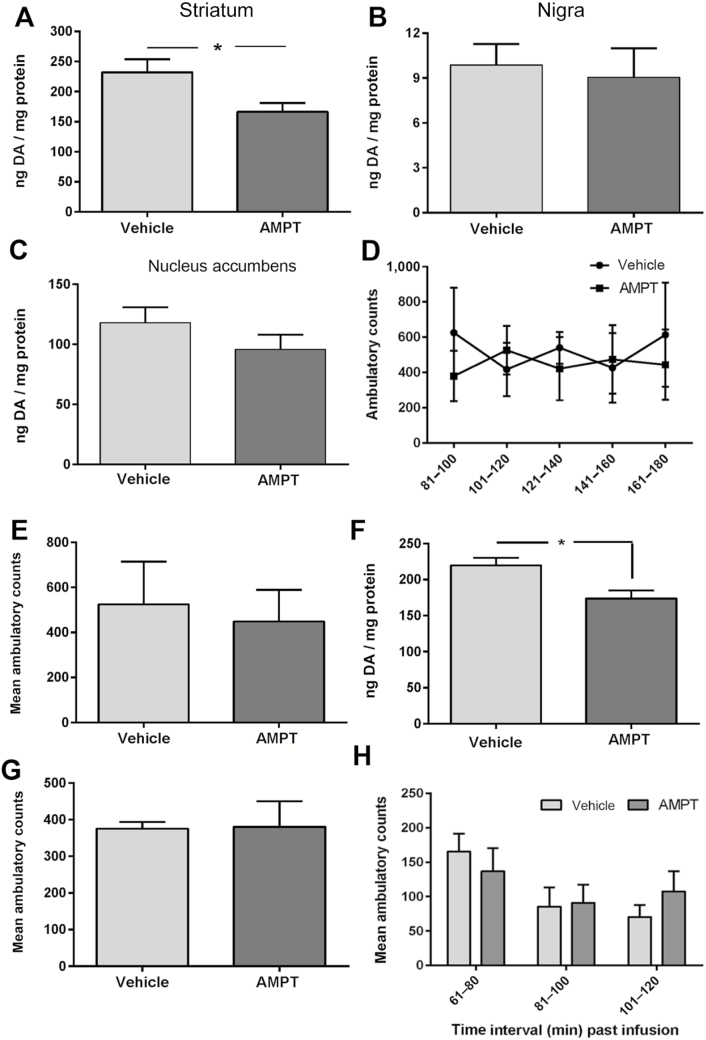Figure 7.
Specificity of striatal dopamine (DA) reduction and impact on locomotor function. α-Methyl-p-tyrosine (AMPT)-mediated reduction of DA tissue content 3 hours following 2.1 nmole AMPT infusion in striatum (A–C) and locomotor impact (D, E), AMPT-mediated reduction of striatal DA tissue content 90 minutes following with 21 nmole AMPT infusion in striatum (F) and locomotor impact (G). (A) Dorsal striatum. DA tissue content decreased 30%, 3 hours following 2.1 AMPT nmole infusion (t = 2.50, * p < .05, df = 12). (B) Substantia nigra. DA tissue content in the substantia nigra (SN) was unaffected by striatal AMPT infusion (t = 0.35, ns, df = 12). (C) Nucleus accumbens. DA tissue content in the nucleus accumbens was unaffected by striatal AMPT infusion (t = 1.24, ns, df = 12). (D) Striatal AMPT (2.1 nmole) impact on locomotor activity. Ambulatory counts in rats 81–180 minutes following AMPT into the striatum were not significantly different versus ambulatory counts in the same time period following vehicle infusions. Data represent the sum of ambulatory counts obtained over five trails for each rat following infusion of either vehicle or AMPT. Repeated measures two-way analysis of variance (ANOVA) results: AMPT effect: (F(4,16) = 0.15, p = .96). Time following infusion: (F(1,4) = 0.32, p = .60). There was no significant interaction of time following infusion × AMPT (F(4,16) = 1.02, p = .43). Post hoc test results: 81–100 minutes, t = 1.67, ns; 101–120 minutes, t = 0.74, p = .47; 121–140 minutes, t = 0.80, ns; 141–160 minutes, t = 0.32, ns; 161–180 minutes, t = 1.15, ns. (E) Total ambulatory counts between 81 and 180 minutes. The mean sum of ambulatory counts during 81–180 minutes following striatal AMPT infusion (2.1 nmole) versus that following vehicle infusion was not significantly different (paired t test matched for test subject [t = 0.57, ns, df = 4; 5 rats]). (F) DA tissue content, dorsal striatum. DA tissue content decreased 30%, 90 minutes following 21 AMPT nmole infusion (t = 2.99, *p < .05, df = 11). (G) Mean of sum total ambulatory counts 61–120 minutes following AMPT (21 nmole) infusion. The mean sum of ambulatory counts 61–120 minutes following striatal AMPT infusion (21 nmole) was not significantly different versus that following vehicle infusion (paired t test matched for sum of each test subject [t = 0.08, ns, df = 4; 5 rats]). (H) Reduced striatal DA impact on ambulatory counts 61–120 minutes. Given similar striatal DA reduction from either 2.1 (31) or 21 nmole of AMPT (Figure 7F) of ~30%, mean ambulatory counts between 61 and 120 minutes following vehicle or AMPT infusion were analyzed by two-way ANOVA. The time past infusion was significant (F(2,18) = 9.82, p = .0013). No significant overall difference in mean ambulatory counts following AMPT infusion versus vehicle infusion was observed (F(1,9) = 0.10, ns).

